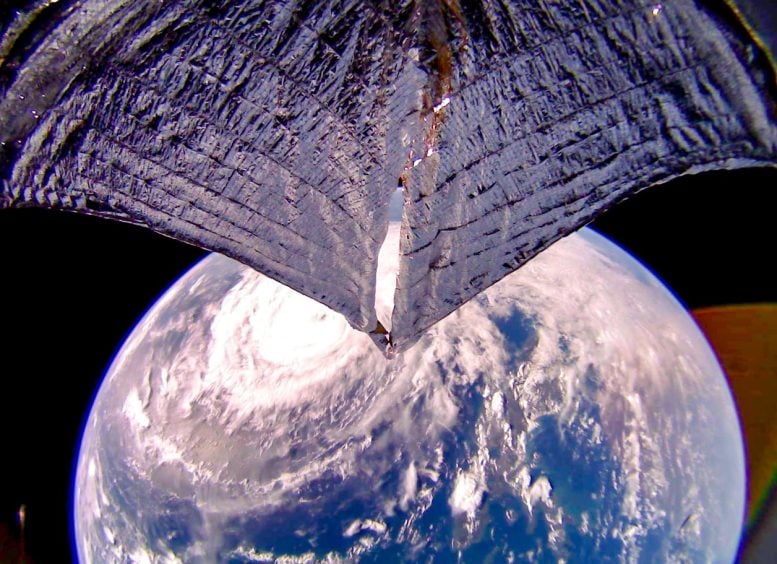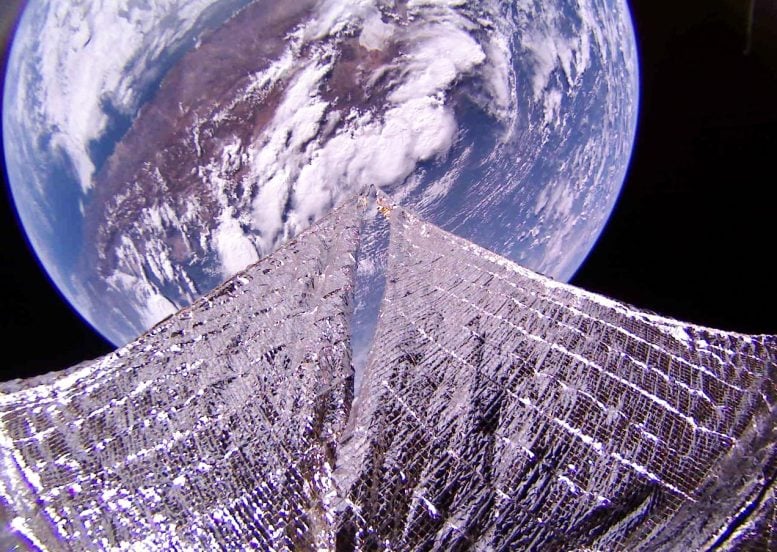
This image taken by The Planetary Society’s LightSail 2 spacecraft on November 13, 2020 shows the northern Philippines and Typhoon Vamco. North is approximately at upper right. Spectraline (fishing line type material) that originally held the spacecraft panels closed can be seen in the lower right and left. The image has been color-adjusted and some fisheye lens distortion has been removed. Credit: The Planetary Society
Even after 30 months in space, The Planetary Society’s LightSail 2 mission continues to successfully “sail on sunbeams” demonstrating solar sail technology in Earth orbit. The mission is providing hard data for future missions that hope to employ solar sails to explore the cosmos.
LightSail 2, a small cubesat, launched in June 2019 on a SpaceX Falcon Heavy, as a demonstration mission to test how well a solar sail could change the orbit of a spacecraft. A month after launch, when LightSail 2 unfurled its ultra-thin 32-square-meter Mylar sail, the mission was declared a success because the sail raised the orbit of the small, loaf-of-bread-sized spacecraft.
That launch nebula, though. 😲
This was the view on June 25, 2019, the night our LightSail 2 mission blasted into orbit. It rode into space on a @SpaceX Falcon Heavy rocket along with 23 other spacecraft. It was amazing! pic.twitter.com/ls7I84nyWf
— Planetary Society (@exploreplanets) November 16, 2021
“We’re going to a higher orbital altitude without rocket fuel, just with the push of sunlight,” The Planetary Society’s (TPS) CEO Bill Nye said at a press conference following the deployment. “This idea that you could fly a spacecraft and could get propulsion in space form nothing but photons, it’s surprising, and for me, it’s very romantic that you’d be sailing on sunbeams.”
TPS, whose members funded the $7 million mission, said it shares mission data with NASA to assist three upcoming solar sail missions: NEA Scout, Solar Cruiser, and ACS3. NEA Scout is scheduled to hitch a ride to lunar space as early as February 2022 on NASA’s Space Launch System rocket during the Artemis I test flight. The mission will use its solar sail to leave the vicinity of the Moon and visit an asteroid.
Solar sails use the power of photons from the Sun to propel spacecraft. While photons have no mass, they can still transfer a small amount of momentum. So, when photons hit the solar sail, the craft is pushed very slightly away from the Sun. Over time, if a spacecraft is out in space without any atmosphere to encumber it, it could potentially accelerate to incredibly high speeds.
A spacecraft with a solar sail wouldn’t need to carry fuel and so could theoretically travel for longer periods of time, as it wouldn’t need to refuel.
But LightSail 2 is in orbit around the Earth. As the spacecraft swings its sails into the sunlight, it raises its orbit by as much as a few hundred meters a day. But the small spacecraft doesn’t have the means to tilt the sails precisely enough to prevent lowering its orbit on the other side of the planet. Eventually, LightSail 2 will dip far into the Earth’s atmosphere to succumb to atmospheric drag. It will deorbit and burn up.

This image of Chile was taken by LightSail 2 on February 17, 2020. The Uyuni Salt Flat in Bolivia can be seen at the top-center. North is at right. The sail appears slightly curved due to the spacecraft’s 185-degree fisheye camera lens. The image has been color adjusted and some of the distortion has been removed. Credit: The Planetary Society
A recent update from TPS says that LightSail 2’s altitude above Earth is currently about 687 kilometers.
“Thanks to optimized sail pointing over time, altitude decay rates during recent months have been the best of the entire mission,” wrote TPS’s Jason Davis. “Thrust even occasionally overcame atmospheric drag, slightly raising the spacecraft’s orbit. Additionally, below-average Sun activity has kept Earth’s upper atmosphere thin for much of the mission, creating less drag on the sail.”
But the Sun has recently become more active, emitting significant solar flares. The LightSail 2 team believes that this activity is likely now causing higher orbital decay rates than those seen earlier in the mission. However, mission engineers estimate the spacecraft could stay in orbit for at least another year.
And in the meantime, while the spacecraft keeps sending back incredible pictures from orbit, engineers continue to glean insights that can be passed along to future missions.
Note: If you are planning to visit the Smithsonian in Washington D.C., models of LightSail 2 will be part of a new display at the Smithsonian’s FUTURES exhibition, a collection of art and technology that showcases the future of humanity. The new exhibition begins November 20, 2021 at the Arts and Industries Building on the National Mall in Washington, D.C. and will continue until July of 2022. More info from TPS here.
Originally published on Universe Today.










